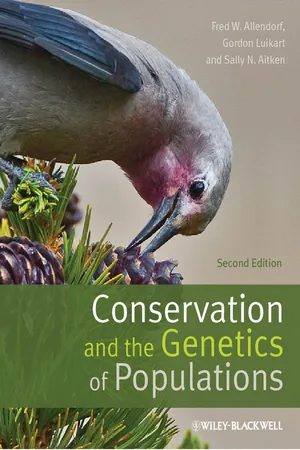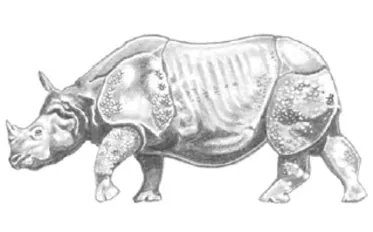![]()
PART I
INTRODUCTION
![]()
CHAPTER 1
Introduction
One-horned rhinoceros, Section 5.3
We are at a critical juncture for the conservation and study of biological diversity: such an opportunity will never occur again. Understanding and maintaining that diversity is the key to humanity’s continued prosperous and stable existence on Earth.
US National Science Board Committee on Global Biodiversity (1989)
The extinction of species, each one a pilgrim of four billion years of evolution, is an irreversible loss. The ending of the lines of so many creatures with whom we have traveled this far is an occasion of profound sorrow and grief. Death can be accepted and to some degree transformed. But the loss of lineages and all their future young is not something to accept. It must be rigorously and intelligently resisted.
Gary Snyder (1990)
Chapter Contents
1.1 Genetics and civilization
1.2 What should we conserve?
1.3 How should we conserve biodiversity?
1.4 Applications of genetics to conservation
1.5 The future
Guest Box 1 The role of genetics in conservation
We are living in a time of unprecedented extinctions (Myers and Knoll 2001, Stuart et al. 2010, Barnosky et al. 2011). Current extinction rates have been estimated to be 50–500 times background rates and are increasing; an estimated 3000–30,000 species go extinct annually (Woodruff 2001). Projected extinction rates vary from 5–25% of the world’s species by 2015 or 2020. Approximately 23% of mammals, 12% of birds, 42% of turtles and tortoises, 32% of amphibians, 34% of fish, and 9–34% of major plant taxa are threatened with extinction over the next few decades (IUCN 2001, Baillie et al. 2004). Over 50% of animal species are considered to be critically endangered, endangered, or vulnerable to extinction (Baillie et al. 2004). A recent assessment of the status of the world’s vertebrates, based on the International Union for the Conservation of Nature (IUCN) Red List, concluded that approximately 20% are classified as Threatened. This figure is increasing primarily because of agricultural expansion, logging, overexploitation, and invasive introduced species (Hoffmann et al. 2010).
The true picture is much worse than this because the conservation status of most of the world’s species remains poorly known. Recent estimates indicate that less than 30% of the world’s arthropod species have been described (Hamilton et al. 2010). Less than 5% of the world’s described animal species have been evaluated for the IUCN Red List. Few invertebrate groups have been evaluated, and the evaluations that have been done have tended to focus on molluscs and crustaceans. Among the insects, only the swallowtail butterflies, dragonflies, and damselflies have received much attention.
Conservation biology poses perhaps the most difficult and important questions ever faced by science (Pimm et al. 2001). The problems are difficult because they are so complex and cannot be approached by the reductionist methods that have worked so well in other areas of science. Moreover, solutions to these problems require a major readjustment of our social and political systems. There are no more important scientific challenges because these problems threaten the continued existence of our species and the future of the biosphere itself.
1.1 GENETICS AND CIVILIZATION
Genetics has a long history of application to human concerns. The domestication of animals and cultivation of plants is thought to have been perhaps the key step in the development of civilization (Diamond 1997). Early peoples directed genetic change in domestic and agricultural species to suit their needs. It has been estimated that the dog was domesticated over 15,000 years ago, followed by goats and sheep around 10,000 years ago (Darlington 1969, Zeder and Hess 2000). Wheat and barley were the first crops to be domesticated in the Old World approximately 10,000 years ago; beans, squash, and maize were domesticated in the New World at about the same time (Darlington 1969, Kingsbury 2009).
The initial genetic changes brought about by cultivation and domestication were not due to intentional selection but apparently were inadvertent and inherent in cultivation itself. Genetic change under domestication was later accelerated by thousands of years of purposeful selection as animals and crops were selected to be more productive or to be used for new purposes. This process became formalized in the discipline of agricultural genetics after the rediscovery of Mendel’s principles at the beginning of the 20th century.
The ‘success’ of these efforts can be seen everywhere. Humans have transformed much of the landscape of our planet into croplands and pasture to support the over 7 billion humans alive today. It has been estimated that 35% of the Earth’s ice-free land surface is now occupied by crops and pasture (Foley et al. 2007), and that 24% of the primary terrestrial productivity is used by humans (Haberl et al. 2007). Recently, however, we have begun to understand the cost at which this success has been achieved. The replacement of wilderness by human-exploited environments is causing the rapidly accelerating loss of species and ecosystems throughout the world. The continued growth of the human population and their direct and indirect effects on environments imperils a large proportion of the wild species that now remain.
Aldo Leopold inspired a generation of biologists to recognize that the actions of humans are embedded into an ecological network that should not be ignored (Meine 1998). The organized actions of humans are controlled by sociopolitical systems that operate into the future on a timescale of a few years at most. All too often our systems of conservation are based on the economic interests of humans in the immediate future. We tend to disregard, and often mistreat, elements that lack economic value but that are essential to the stability of the ecosystems upon which our lives and the future of our children depend.
In 1974, Otto Frankel published a landmark paper entitled ‘Genetic conservation: our evolutionary responsibility’, which set out conservation priorities:
First, … we should get to know much more about the structure and dynamics of natural populations and communities. … Second, even now the geneticist can play a part in injecting genetic considerations into the planning of reserves of any kind. … Finally, reinforcing the grounds for nature conservation with an evolutionary perspective may help to give conservation a permanence which a utilitarian, and even an ecological grounding, fail to provide in men’s minds.
Frankel, an agricultural plant geneticist, came to the same conclusions as Leopold, a wildlife biologist, by a very different path. In Frankel’s view, we cannot anticipate the future world in which humans will live in a century or two. Therefore, it is our responsibility to “keep evolutionary options open”. It is time to apply our understanding of genetics to conserving the natural ecosystems that are threatened by human civilization.
1.2 WHAT SHOULD WE CONSERVE?
Conservation can be viewed as an attempt to protect the genetic diversity that has been produced by evolution over the previous 3.5 billion years on our planet (Eisner et al. 1995). Genetic diversity is one of three forms of biodiversity recognized by the IUCN as deserving conservation, along with species and ecosystem diversity (www.cbd.int, McNeely et al. 1990). Unfortunately, genetics has been generally ignored by the member countries in their National Biodiversity Strategy and Action Plans developed to implement the Convention on Biological Diversity (CBD) (Laikre et al. 2010a).
We can consider the implications of the relationship between genetic diversity and conservation at many levels: genes, individuals, populations, varieties, subspecies, species, genera, and so on. Genetic diversity provides a retrospective view of evolutionary lineages of taxa (phylogenetics), a snapshot of the current genetic structure within and among populations (population and ecological genetics), and a glimpse ahead to the future evolutionary potential of populations and species (evolutionary biology).
1.2.1 Phylogenetic Diversity
The amount of genetic divergence based upon phylogenetic relationships is often considered when setting conservation priorities for different species (Mace et al. 2003, Avise 2008). For example, the United States Fish and Wildlife Service (USFWS) assigns priority for listing under the Endangered Species Act (ESA) of the United States on the basis of “taxonomic distinctiveness” (USFWS 1983). Species of a monotypic genus receive the highest priority. The tuatara raises several important issues about assigning conservation value and allocating our conservation efforts based upon taxonomic distinctiveness (Example 1.1).
Example 1.1 The Tuatara: A Living Fossil
The tuatara is a lizard-like reptile that is the remnant of a taxonomic group that flourished over 200 million years ago during the Triassic Period (Figure 1.1). Tuatara are now confined to some 30 small islands off the coast of New Zealand (Daugherty et al. 1990). Three species of tuatara were recognized in the 19th century. One of these species is now extinct. A second species, Sphenodon guntheri, was ignored by legislation designed to protect the tuatara which ‘lumped’ all extant tuatara into a single species, S. punctatus.
Daugherty et al. (1990) reported allozyme and morphological differences from 24 of the 30 islands on which tuatara are thought to remain. These studies support the status of S. guntheri as a distinct species and indicate that fewer than 300 individuals of this species remain on a single island, North Brother Island in Cook Strait. Another population of S. guntheri became extinct earlier in this century. Daugherty et al. (1990) argued that not all tuatara populations are of equal conservation value. As the last remaining population of a distinct species, the tuatara on North Brother Island represent a greater proportion of the genetic diversity remaining in the genus Sphenodon and deserve special recognition and protection. However, recent results with other molecular techniques indicate that the tuatara on North Brother Island probably do not warrant recognition as a distinct species (Hay et al. 2010, Example 16.3).
On a larger taxonomic scale, how should we value the tuatara relative to other species of reptiles? Tuatara species are the last remaining representatives of the Sphenodontida, one of four extant orders of reptiles (tuatara, snakes and lizards, alligators and crocodiles, and tortoises and turtles). In contrast, there are approximately 5000 species in the Squamata, the speciose order that contains lizards and snakes.
One position is that conservation priorities should regard all species as equally valuable. This position would equate the two tuatara species with any two species of reptiles. Another position is that we should take phylogene...



